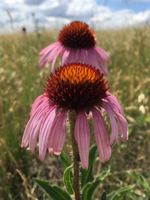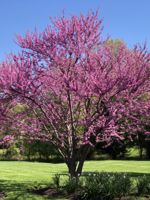Mon-Fri 9am - 5pm Mountain time
Narrow-Leaved Coneflower (Echinacea) vs Eastern Redbud
Echinacea angustifolia
Cercis canadensis
NOT AVAILABLE THIS SEASON - MIGHT RETURN
Narrow-Leaved Coneflower is a native perennial wildflower known for its pink to pale purple, daisy-like blooms. The petals (rays) droop downwards, around a dark, domed center, giving the flower a cone-like appearance. The nectar-rich blossoms attract a wide variety of pollinators, including native bees and butterflies. After flowering, the seeds provide food for birds, further adding to its ecological value.
Once established, it is drought-tolerant due to its deep taproot, which also helps stabilize soil. Narrow-Leaved Coneflower thrives in a variety of well-drained soils, including sandy, rocky, and alkaline. It often grows alongside the native grasses that characterize prairie and grassland ecosystems, making it well-suited for prairie and grassland restoration, naturalization, and pollinator gardens.
The Eastern Redbud is known for the pea-like pink buds that emerge in clusters on the bark, embellishing the tree in stunning flowers. They have a longer bloom time, sometimes for two to three weeks before the heart-shaped leaves emerge for the summer. Inedible pods emerge that turn brown in the summer, this tree is a part of the bean family.
Native to the Eastern North America. The Eastern Redbud can tolerate acidic and alkaline soil. Plant this as a beautiful understory species or shaded residential yard or garden. The bright pop of color will make an attractive ornamental tree.

